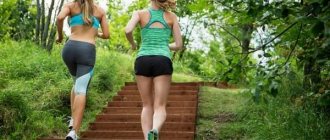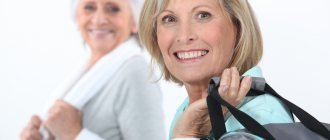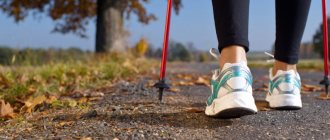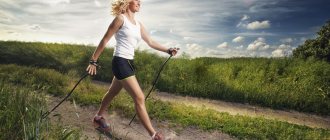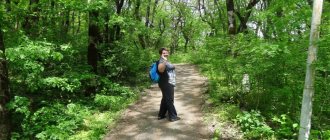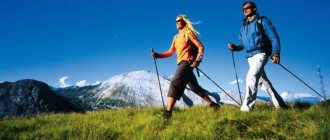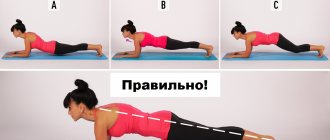Among retirees, there are more and more active people who strive to improve their health through measured physical activity. Nordic walking has gained great popularity, although not everyone clearly understands why it is useful and what role it plays in healing the body. In addition, many do not take into account that the rules of Nordic walking with poles are different for young and elderly people. Let's talk about this in more detail.
What is Nordic walking with poles?
Scandinavian or Nordic walking (also called Finnish) is a method of moving on foot using special sticks - Nordics. Such training became widespread in the 1990s and remains relevant to this day. Nordic walking is especially beneficial for older people, since it does not require special skills or physical training and has almost no contraindications. You can read in more detail about the main features and effects of walking with Nordic poles on the body in this article.
Walking rules
Now we will give you Nordic walking lessons. More precisely, we’ll tell you how to move, step by step:
- Stand straight, bend your knees slightly. Move your left hand back and hold the stick in it at an angle. Bend your right arm at the elbow. Then pull it forward strongly.
- Now take a step with your left foot, while moving your right hand back. Try to smoothly transfer your weight onto the stick in front. Keep your elbows straight! The right hand goes back, and the stick in it almost hangs on the straps. The palm is slightly relaxed. The technique is simple: right hand - left leg, left hand - right leg.
- When you take a step, step onto your heel first. Then roll smoothly onto your toes.
- Move slowly to learn proper technique. In fact, it will be just walking. But in the process you are dragging sticks behind you. Secure the correct positions of your legs and arms.
- Now about breathing - inhale through your nose every 2 steps. Exhale through your mouth on step 4.
- When you master this type of walking well, you will begin to push off. First from one stick, then from two at once.
For a better understanding, study the video and watch professional master classes.
I assure you, training will not take much time. I recommend following the link to the article “Nordic walking for beginners.”
For what diseases is Nordic walking beneficial?
Like any sports technique, Nordic walking has its indications and contraindications (we wrote about this in great detail here). Exercise is especially beneficial for people suffering from certain chronic diseases:
- Mild or moderate hypertension;
- Atherosclerosis;
- Bronchial asthma or chronic bronchitis;
- Diabetes mellitus without severe complications;
- Obesity;
- Osteoporosis;
- Arthrosis, osteochondrosis;
- Chronic cerebral ischemia;
- Coronary heart disease (mild angina, consequences of myocardial infarction);
- Parkinsonism.
Nordic walking is also relevant for older people who do not have serious health problems. In this case, it has a general strengthening effect on the body, increases immune defense, normalizes sleep, tones the nervous system, heart and blood vessels.
Contraindications
Even such a harmless type of training as brisk walking has a number of contraindications. If you have recently had surgery or have chronic diseases, then it is better not to start without a doctor’s permission. Fast walking should be stopped when:
- dizziness;
- pain in the chest area;
- frequent shortness of breath;
- rapid weight loss;
- non-healing wounds;
- crunching and discomfort in the joints.
Main contraindications for older people
Not all older people benefit from Nordic walking; in case of severe illnesses, exercise can cause serious harm to the body. Classes are contraindicated for:
- Acute course of stroke;
- Severe heart failure and severe heart disease (unstable angina, heart attack, arrhythmias, aortic aneurysm);
- Active infectious disease with general malaise and high fever;
- Thrombosis, thrombophlebitis of veins;
- Uncontrolled hypertension with blood pressure numbers above 170/110 mm Hg;
- Having undergone abdominal surgery within 1–2 months.
Note!
The duration of the protective regime after surgery, in which physical activity is contraindicated, is determined by the attending physician. In some cases, a month is enough, but in other circumstances, the recovery period can last up to six months.
The benefits and harms of walking for the male body
Due to the fact that walking loads the entire musculoskeletal system, it is definitely recommended for all athletes and men involved in building muscle mass.
With such a load, the pituitary gland is activated - a part of the brain that produces growth hormone and promotes the absorption of essential amino acids from food.
Read: What are the benefits of Nordic walking?
Regular walking increases stamina and performance in men, improves reaction speed and relieves stress by releasing endorphins.
Thanks to increased blood circulation, you can also count on the following effects:
- prevention of erectile dysfunction;
- treatment of prostatitis;
- strengthening the detoxification function of the liver.
Walking makes it easier to quit smoking and, by activating the production of the already mentioned “happiness” hormones, makes it easier to give up alcohol and smoking.
Sometimes the doctor may limit walking in case of severe exacerbation of prostatitis.
Video on the topic:
https://youtu.be/yo0uj8qaQNI
https://youtu.be/8Kj-aFnm8bU
What special equipment is required?
To practice Finnish walking you need special poles, called Nordics, and comfortable sportswear. Sticks must be selected individually in accordance with height and anatomical features.
Clothing should be loose and breathable. The best option is a sports suit made from natural fabrics. In the cold season, choose a warmer suit and wear multi-layered clothing underneath. It retains heat better than one warm sweater. In addition, if you get hot, you can get rid of one layer of clothing. Overheating and excessive sweating during training are unacceptable.
It is better to wear lightweight sneakers with thick soles, in which you can walk not only on asphalt. For the winter, choose an insulated version, under which you wear warm socks. This must be taken into account when determining your shoe size. Winter sneakers should have a grooved sole that reduces the likelihood of slipping.
How to choose inventory
The benefits of Nordic walking for the elderly are due to the use of special poles, which are important to choose correctly. They make the work of the limbs easier, help avoid excessive fatigue, and most importantly, prevent damage - bones and cartilage become thinner over time, which is why they are often injured even with slight pressure. To determine the required length of poles, a formula has been developed: height * 0.68. In addition, the equipment should be convenient, stable and easy to use - there are both monolithic and adjustable models, so there are usually no problems with the choice. You cannot use ski poles - only those workouts that are carried out using appropriate equipment, which can be purchased at sports stores, will be effective. It is designed specifically for this type of recreational sport, and the use of inappropriate equipment can lead to unpleasant consequences and injuries.
Clothes that are loose and comfortable are chosen so that they do not restrict movement, do not impede the access of air and repel moisture. In cold weather, you can dress warmer, but too heavy clothes will cause discomfort, so it is better to insulate yourself in several layers. It is recommended to take still water or ice tea with you and drink as much as possible, but only when needed. Food is taken no later than two hours before leaving, and upon arrival home you can have a light snack.
Rules for older people
Nordic walking has some peculiarities for older people, associated with their lack of resistance to physical activity and reduced adaptive capabilities. The best time to start Nordic walking is spring. It is better to exercise in the morning or evening.
Warm-up and preparation
Any training complex should be preceded by a ten-minute warm-up. Warm-up exercises performed before Nordic walking include:
- Smooth tilts and head turns.
- Circular movements, shoulder rotation.
- Turns, tilts of the body.
- Swing your legs forward, backward, to the sides.
- Nordic supported squats.
- Walking on toes, on heels.
This short program will prepare the muscles of the arms, legs, and torso for stress, and will accelerate the adaptation of the cardiovascular and respiratory systems.
Intensity of classes
To determine the adequacy of the load, you first need to focus on the heart rate. The pulse is counted before the start of the workout. With maximally accelerated walking, this figure should not increase by more than 15%.
Important!
In patients taking medications that slow the heart rate, the increase may be smaller. In this case, it is better to check your individual heart rate norms with your doctor.
You cannot train for too long, even at a slow pace. Walk as much time as your health allows, no need to chase records.
Breath
You should breathe rhythmically while moving, without pauses. To achieve this, people walking should not talk. When performing breathing movements, it is mainly the stomach that works: it protrudes as you inhale and retracts as you exhale.
Correct breathing is through the nose, with the exhalation being longer than the inhalation. On average, each inhalation takes 2-3 steps, and each exhalation takes 3-4.
Note!
If you experience shortness of breath during class, then you have taken the pace too fast. You need to slow down and rest until your breathing is completely equalized.
Correct walking technique
The Nordic walking technique with poles is the same for older and younger people:
- Synchronized repulsion is performed by opposite limbs. For example, right hand and left foot.
- The hand moves from the shoulder like a pendulum.
- The Nordic rests on the ground at an acute angle.
- The posture remains straight, the body is slightly tilted forward.
- Each step involves a smooth roll from heel to toe.
- When the hand is pulled back for a few moments, the stick is released so that the hand can rest.
Please read more about the Finnish walking technique in this material.
Completing the workout
Towards the end of the lesson, the pace of walking is gradually slowed down, at this time breathing evens out and the pulse slows down. As a cool-down, warm-up elements are performed with an emphasis on muscle stretching. About a quarter of an hour is allotted for them. If it is difficult for older people to maintain balance, then when performing exercises - swings, squats, bends - they are allowed to lean on Nordics.
Reviews
Larisa, 58 years old.
“I look for meaning in any activity, otherwise I lose all interest in it. When I first picked up Nordic walking sticks, I realized that it would be very easy for me to find meaning in this case.
I have been trying to lose weight for many years. Having tried various methods, I realized that in any physical exercise, specifically for me, there is some element of violence. I had to force myself to do this or that exercise, so I wasn’t able to do it for a long time. But when I started Nordic walking, I immediately realized that it was for me! It's so organic and correct! I don't have to put any effort into doing this exercise. You just walk, and your body becomes healthier, stronger and fitter.
After each lesson, I feel an incredible surge of energy and inner strength!”
Tamara, 63 years old.
“My old friend told me about Nordic walking. I decided to try it and, to be honest, I really liked it. I like to spend my free time in the fresh air, because then the whole body is well saturated with oxygen, my head becomes clear and bright.
I really like that for Nordic walking you need to use special sticks.
They give me a lot of positive emotions and make others smile! I especially love it when complete strangers I pass by nod approvingly. And some come up and ask why I’m doing so interesting. I recommend everyone to try Nordic walking.” Anatoly, 61 years old.
“I walk my dog every day, but that’s not enough to train my muscles. I do Nordic walking to keep my body in good shape. I started two years ago. I remember the flu hit me pretty hard back then. Having recovered from the flu, I decided that I needed to strengthen my immune system. A distant relative advised me to buy Nordic walking poles and start training regularly. At first I was overcome by laziness, I didn’t want to practice walking with poles at all, but then I got into it and began to really enjoy this activity.
To be honest, since then I have never gotten sick; flu and colds have passed me by. And the muscles are in excellent condition. I can give both forty and fifty year old men a head start!”
Ekaterina, 52 years old.
“One day I was sitting at work and suddenly felt that my sedentary lifestyle was slowly killing me. It was a real epiphany! I decided that I would walk more. But regular walking has never interested me. A colleague, having learned about this, invited me to try Nordic walking with her. I gladly joined her and don’t regret it one bit! Started to feel much better! I recommend to everyone!".
A complete Nordic walking lesson for beginners
https://youtu.be/umM4uS7EfS4
If you find an error, please select a piece of text and press Ctrl+Enter.
How the load is selected for older people
The load largely depends on the patient’s well-being and his initial physical fitness. We will provide only general recommendations for selecting adequate physical activity.
Walking speed
The average speed of movement is 5 km/h, but this figure is variable. You need to start walking at a slow pace: 60-80 steps per minute. Gradually move to an average pace - 80-100 steps per minute. It is better to speed up the pace on certain sections of the path, then gradually slow down and after a rest go faster again. If there is a forced break in classes, then you need to resume training again with light loads.
Number of classes and their duration
The Nordic walking process itself, without warming up or cooling down, takes 20-60 minutes for pensioners. How many times a week you need to walk with poles depends on the person’s health and level of physical fitness. Usually, for older people, doctors recommend exercising every other day or every day, gradually increasing the duration and intensity of walking so as not to cause harm to health.
Route and terrain
During the first months of training, it is best for retirees to walk on level terrain to minimize the risk of tripping, slipping and falling. In the future, you can move on to training on rough terrain with a slight slope. The best option is routes remote from the city, where the air is cleaner and conditions are calmer.
Note!
Don't forget to plan your route in such a way that you still have the strength to return home.
Reducing the risk of premature death
At the age of 40–50, people are at the peak of developing bad habits that can cause death. A sedentary lifestyle is no better for the body than smoking. Even ten minutes of walking a day will reduce the risk of premature death by 15%. Moreover, it is not necessary to walk purposefully: you can park your car a block from work and walk further, and instead of the elevator, take the stairs.
Walking technique for the elderly is the same as for everyone else - you need to walk quickly.
This rate reduces the risk of early death from cardiovascular diseases by 53%. For those who adhere to average speed, this figure is 46%. The result is not affected by weight, gender, body mass index - it all depends on the pace. Slow walks are less effective and are recommended for serious heart disease.
- How to pay an administrative fine correctly
- 5 most necessary documents for applying for a pension
- 7 reasons for increased sweating in women
Nordic walking for older people without mistakes
Errors when walking with poles are typical not only for older people, but for all trainees. The most common ones are:
- Immobility of the shoulder girdle. When walking, the arm should bend not only at the elbow level, but also at the shoulder joint.
- Insufficient range of motion when, instead of moving backwards, the arms remain at the level of the body.
- Uneven placement of poles. According to the rules, they should be placed parallel to each other.
- Imitation of a sliding ski step. It is necessary to roll from heel to toes, and not slide.
- Loose brush. Normally, the hand remains motionless at the wrist.
- The placement of the poles is too wide, which prevents full repulsion.
- Constantly tense hands. According to the rules, the arms relax when pulled back.
Following these rules seems difficult only at first. Over time, muscle memory is formed and movements become automated.
How quickly does the positive effect appear?
To achieve a visible effect, regular, systematic exercises are required in compliance with all the rules. The first changes are usually noticeable after 4-5 workouts, but a lasting improvement in health occurs only after a year of full-fledged training. Some diseases (arthrosis, asthma, bronchitis) are corrected within several months, others require longer-term movement therapy (osteoporosis, diabetes, atherosclerosis).
Nordic walking is one of the most effective ways to maintain physical activity in older people. It can be combined with other workouts approved by your doctor. Another advantage of Nordic walking is the expansion of your social circle when practicing in a group of like-minded people.

